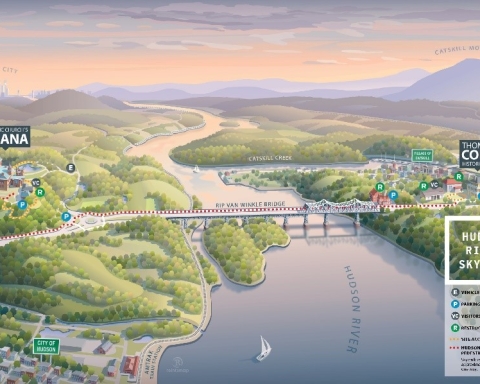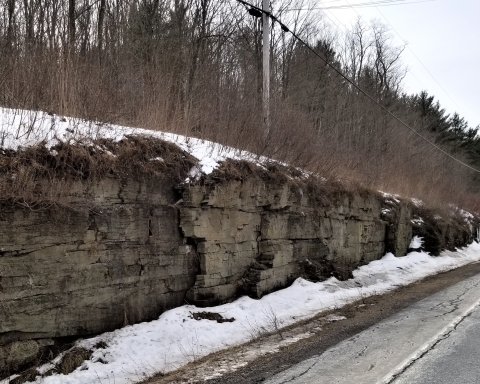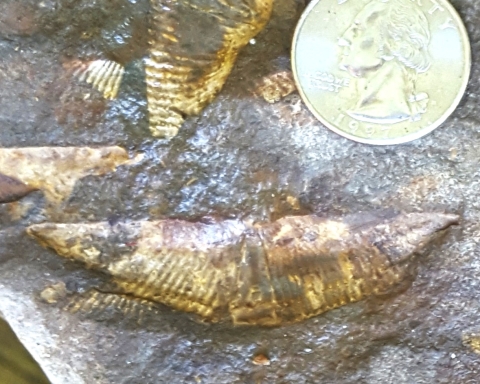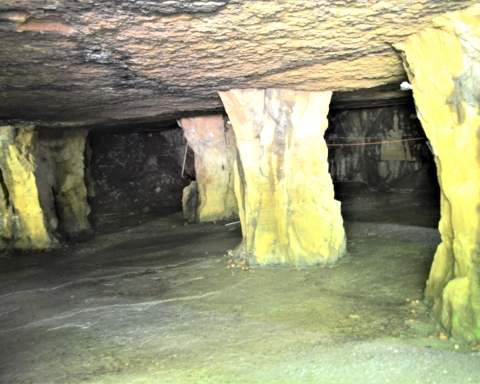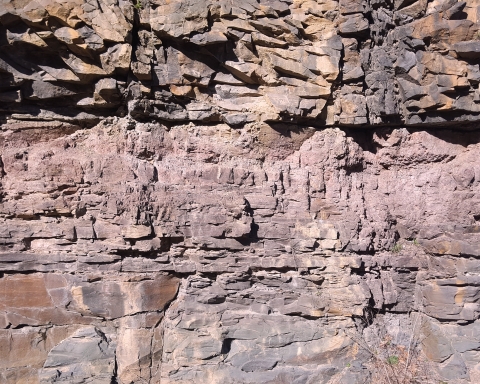Visions of a distant past: Part 8 – Newman’s Ledge
On the Rocks Woodstock Times – July, 2013
Robert Titus
One of the most popular hiking routes of the North Lake vicinity is the Blue Trail heading north from the North Lake parking lot. You follow the trail along the edge of the Catskill Escarpment and, here and there along the way, are a number of wondrous views. Most vistas allow you to gaze out across the Hudson Valley. In the far distance are the modern Taconic Mountains, mere remnants of the towering range that once dominated our eastern horizon. Some views allow you to look back toward North Lake itself. Beyond that is South Mountain and then the Shawangunk Mountains. The Blue Trail offers a grand series of scenes, always worth the effort, no matter how many times you make the trek.
But to a geologist there is an altogether different set of views. These are mind’s eye journeys into the geological past of North Lake. Some of these journeys can take us back to a time when glaciers reigned over the landscape, up and down the Hudson Valley and east and west into the Taconics and Catskills. A geologist is treated to a choice of moments that can be visited. You can, if you wish, pick that exact time when the glaciers had reached their peak and loomed high upon all the horizons. Then you can choose to view these great masses of ice at a noontime hour when they shined a brilliant white. Or you can visit on a night when the full moon has reached its highest. The glacial ice all around basks in the ghostly moonlight, reflecting it with a silvery sheen, producing a luminous aura all around a 360 degree sweep of the horizon.
Perhaps a better time to visit the Ice Age past is to pick a moment near the end of that epoch, a time when the ice was enduring a destructive melting. We start out in today’s world and hike north. Our goal is the first sheer cliff that can be called Newman’s Ledge. It’s just short of where the Yellow Trail peels off from the Blue Trail. The Yellow Trail takes hikers out to Sunset Rock where they receive, even by Catskills standards, a most remarkable sweeping panorama of all of the Hudson Valley and all of North Lake State Park.
But our journey is not out onto the Yellow Trail, it is into the past. Right below Newman’s Ledge we perceive a canyon carved into raw rock. It’s a completely dry canyon, but evidence reveals a complex history. There was once water here – and much more. Subtle striations in the canyon bedrock betray the passage of glacial ice. A stream of ice had peeled off of the Hudson Valley glacier and pushed westward into the North Lake vicinity, creeping past the base of today’s Newman’s Ledge. It was later, while that glacier was melting, that the canyon was carved. We climb up to the very top of the canyon, right where the Yellow Trail begins and we watch the powerful currents that once passed this way. Now we have left our own time and journeyed into a late ice age past.
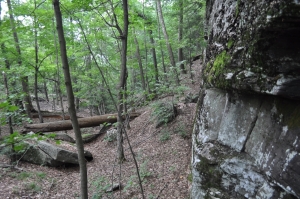
The canyon below Newman’s Ledge
A horrendous torrent of ice water cascades out of the melting Hudson Valley glacier and it has been carving our canyon as it has flowed west and downhill. We look back east and see the top of the Hudson Valley glacier, spread out all across the Hudson Valley. We turn west again and watch that flow of water pass by and then disappear into a great dark tunnel of ice. Beyond, all of what we have known as North Lake is buried in ice. Another, even greater branch of the Hudson Valley glacier has advanced up Kaaterskill Clove and into the North Lake basin. But, at the moment of our visit, this ice, like the Hudson Valley glacier, is melting.
Our stream of whitewater has cut its way into the melting ice and created the sub-glacial tunnel. We cannot resist. We are the mind’s eye; we can travel anywhere and do anything. We are compelled; we are absolutely drawn into that tunnel. Before complete darkness envelops us we look left and right and we see shining walls of ice; the flow of the water has polished these.
We rapidly drift down the passageway and into the dark. It is loud; the din of the pounding flow of water reverberates off the walls. That magnifies what would have been a terribly noisy flow and makes it quite painfully loud. The next part of our journey will be heard and felt but not seen; it is just too dark. We suddenly tumble over the edge of a 50 foot waterfall. We fall to its bottom and get caught up in the swirling chaos of its plunge pool. Next we bob to the surface and are returned to the downhill flow and experience a bumpity-bump ride down this sub-glacial surge. Soon we feel the slope level out and sense that we have reached what will someday be the North Lake basin. Our ride becomes a little less noisy and a little less rough, but we are picking up speed. Quickly, we reach what will someday be South Lake. The tunnel’s ceiling is higher here, but we cannot see that in the blackness.
Now we feel our speed picking up considerably, and we can sense that we are now being sucked farther along to the southwest. We recognize that our tunnel has been drawing us towards Kaaterskill Falls, but these are not the falls we have known from modern times. This ancient version is completely under the ice.
We tumble over the lip of the falls and plunge down more than two hundred feet. The drop is not completely vertical, but it is very steep and very rough. It is a good thing that we are the mind’s eye; otherwise we would have already suffered a hundred deaths.
Next we are being funneled down an ancient version of Kaaterskill Clove. Fully clogged with ice, it is still completely black all around, but we can sense that the bottom of this canyon is very narrow. The very compressed and very powerful flow of meltwater has cut, no sliced into the bedrock, creating walls of rock close to us on either side. That compacted flow has been forced to become even faster than it had been previously; it is an extraordinary torrent of water, a gigantic fire hose.
Once again we sense that we are slowing down. The flow of water is widening and spreading out. We have reached what today is Palenville. A great cavern opens up above and all around us. It has been carved into the Hudson Valley glacier by the meltwater flow. At the top of this icy cavern the glacier is thin enough that a faint glow of light is penetrating it. The image is a dim one but we can see the full expanse of this cavern. It is breathtaking, hundreds of yards across and a hundred yards tall.
Our journey is finished; it has been extraordinary. It has carried us along a flow of water which began back north at the top of the glacier. We plunged under the ice and were swept along through a tunnel that carried us across the future North and South Lakes and then down Kaaterskill Falls. Then we careened down Kaaterskill Clove and then drifted into one of history’s greatest ice caverns.
Reach the author at titusr@hartwick.edu. Join his facebook page “The Catskill Geologist.”

